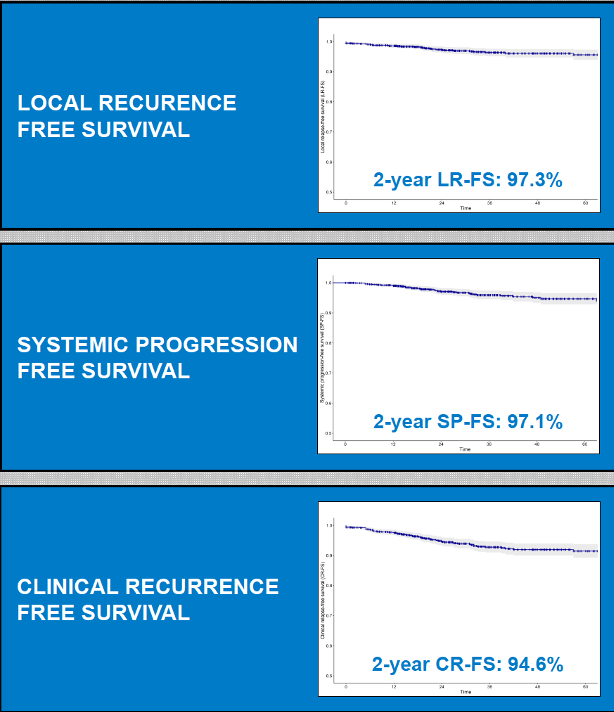There were 1,623 patients diagnosed with a renal mass that elected for robot-assisted partial nephrectomy at nine high volume European, North American, or Asian institutions and were prospectively assessed in a central dataset. Adverse oncologic outcomes consisted of local recurrence (namely RCC in the resection bed), systemic progression (namely RCC outside of the kidney), and clinical relapse (namely any of local recurrence or systemic progression). Kaplan-Meier plots were used to depict adverse oncologic outcomes rates, and Cox-regression multivariable models were used to compute the risk of adverse oncologic outcomes in the preoperative setting (Model A - clinical predictors and overall population) and in the postoperative setting (Model B - pathological predictors and confirmed RCC only).
The Kaplan-Meier derived two-year rates of localized recurrence, systemic progression, and clinical relapse were 2.3%, 2.5%, and 4.5% after a median follow-up of 24 months, respectively, in the overall population. The same figures resulted in 2.7%, 2.9% and 5.4% after a median follow-up of 25 months, respectively, in 1,324 (82%) patients with confirmed RCC:

In the preoperative setting, male gender (for localized recurrence; female vs male hazard ratio [HR] 0.42, 95% confidence interval [CI] 0.18-0.97), larger tumor (for localized recurrence; tumor size in mm HR 1.21, 95% CI 1.04-1.41), and former year of surgery (for localized recurrence; HR 0.85, 95% CI 0.74-0.98) were associated with a higher risk of adverse oncologic outcomes at multivariable analysis (Model A). The c-index for localized recurrence was 0.83, for systemic progression was 0.83, and for clinical relapse was 0.78. In the postoperative setting, male gender for localized recurrence; female vs. male HR 0.42, 95% CI 0.18-0.97), larger tumor (for localized recurrence; tumor size in mm HR 1.21, 95% CI 1.04-1.41), higher tumor grade (for localized recurrence; grade 3-4 vs grade 1-2 HR 2.45, 95% CI 1.25-4.79), positive surgical margins (for localized recurrence; R1 vs R0 HR 3.44, 95% CI 1.38-8.58) and former year of surgery (for localized recurrence; HR 0.85, 95% CI 0.74-0.98) were associated with a higher risk of adverse oncologic outcomes at multivariable analysis (Model B). The c-index for localized recurrence was 0.83, for systemic progression was 0.83, and for clinical relapse was 0.78.
Dr. Larcher concluded his presentation of the IRON project for robot-assisted partial nephrectomy with the following take-home messages:
- Generally, robot-assisted partial nephrectomy is associated with good cancer control, and for the first time, it is possible to estimate the risk of adverse oncologic outcomes such as localized recurrence, systemic progression, and clinical relapse with optimal predictive accuracy
- In the preoperative setting, the proposed model can support clinicians in the choice for the best therapeutic option, while in the postoperative setting it can support clinicians at proper follow-up planning
Co-Authors: Giuseppe Rosiello, Andrea Minervini, Andrea Mari, Karim Bensalah, Zinéddine Khene, Riccardo Schiavina, Lorenzo Bianchi, Eugenio Brunocilla, Alexandre Mottrie , Geert De Naeyer, Alessandro Antonelli, Maria Furlan, Claudio Simeone, Koon Ho Rha, Ahmad Almujalhem , Ithaar Derweesh, Aaronw Bradshaw, Fady Ghali, Jihak Kaouk, Guilherme Sawczyn, Riccardo Bertolo, Umberto Capitanio, Francesco Montorsi
Written by: Zachary Klaassen, MD, MSc, Assistant Professor of Urology, Georgia Cancer Center, Augusta University/Medical College of Georgia, Augusta, Georgia, Twitter: @zklaassen_md, at the 2020 American Urological Association (AUA) Annual Meeting, Virtual Experience #AUA20, June 27- 28, 2020.


